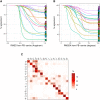Structural coordinates: A novel approach to predict protein backbone conformation
- PMID: 34014953
- PMCID: PMC8136669
- DOI: 10.1371/journal.pone.0239793
Structural coordinates: A novel approach to predict protein backbone conformation
Abstract
Motivation: Local protein structure is usually described via classifying each peptide to a unique class from a set of pre-defined structures. These classifications may differ in the number of structural classes, the length of peptides, or class attribution criteria. Most methods that predict the local structure of a protein from its sequence first rely on some classification and only then proceed to the 3D conformation assessment. However, most classification methods rely on homologous proteins' existence, unavoidably lose information by attributing a peptide to a single class or suffer from a suboptimal choice of the representative classes.
Results: To alleviate the above challenges, we propose a method that constructs a peptide's structural representation from the sequence, reflecting its similarity to several basic representative structures. For 5-mer peptides and 16 representative structures, we achieved the Q16 classification accuracy of 67.9%, which is higher than what is currently reported in the literature. Our prediction method does not utilize information about protein homologues but relies only on the amino acids' physicochemical properties and the resolved structures' statistics. We also show that the 3D coordinates of a peptide can be uniquely recovered from its structural coordinates, and show the required conditions under various geometric constraints.
Conflict of interest statement
The authors have declared that no competing interests exist.
Figures




References
Publication types
MeSH terms
LinkOut - more resources
Full Text Sources
Other Literature Sources
Miscellaneous

